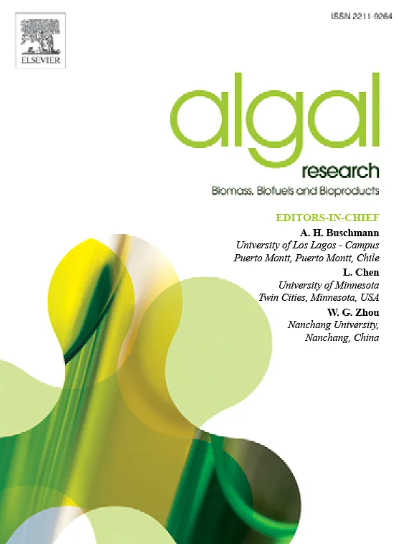Key nutrients and their transportation processes influencing algal growth in a dam-controlled river
IF 4.6
2区 生物学
Q1 BIOTECHNOLOGY & APPLIED MICROBIOLOGY
Algal Research-Biomass Biofuels and Bioproducts
Pub Date : 2025-03-24
DOI:10.1016/j.algal.2025.104017
引用次数: 0
Abstract
A dam-controlled river refers to a river where flow and water levels are regulated through hydraulic engineering structures, such as dams and sluices. This research focuses on controlling eutrophication in dam-controlled rivers, with particular attention to the Huaidian Dam on China's Shaying River. The primary objective of this research was to identify the key nutrients and their transportation processes affecting algal growth during the non-flood season. To achieve this, we analyzed algal density, species diversity, and the distribution of key nutrients, including ammonia nitrogen (NH4+-N), nitrate nitrogen (NO3−-N), and total phosphorus (TP) across dissolved, suspended, and sediment phases in both the hyporheic zone and surface water. The results reveal that diatoms dominate the algal community, comprising 66.91 % of the total composition and displaying higher cell density and biomass. Nutrient concentrations were mainly observed downstream of the dam, with NH4+-N predominantly detected in sediments (2.92–9.23 mg/kg) and pore water (1.1–13.5 mg/L), NO3−-N in sediment (2.5–12 mg/kg), and TP mainly in sediments (50–70 mg/kg). Redundancy analysis demonstrated that NO3−-N in overlying water, sediment, and pore water were critical for algal growth, contributing 78.9 %, 77.5 %, and 75 %, respectively. Our findings suggest that the interaction between NO3−-N transport and transformation within sediments and pore water is a significant factor influencing algal growth during non-flood seasons. This study highlights the influence of nutrient transport and transformation at the water-sediment interface for algal growth and recommends targeted measures to mitigate eutrophication risks in dam-controlled rivers.
求助全文
约1分钟内获得全文
求助全文
来源期刊

Algal Research-Biomass Biofuels and Bioproducts
BIOTECHNOLOGY & APPLIED MICROBIOLOGY-
CiteScore
9.40
自引率
7.80%
发文量
332
期刊介绍:
Algal Research is an international phycology journal covering all areas of emerging technologies in algae biology, biomass production, cultivation, harvesting, extraction, bioproducts, biorefinery, engineering, and econometrics. Algae is defined to include cyanobacteria, microalgae, and protists and symbionts of interest in biotechnology. The journal publishes original research and reviews for the following scope: algal biology, including but not exclusive to: phylogeny, biodiversity, molecular traits, metabolic regulation, and genetic engineering, algal cultivation, e.g. phototrophic systems, heterotrophic systems, and mixotrophic systems, algal harvesting and extraction systems, biotechnology to convert algal biomass and components into biofuels and bioproducts, e.g., nutraceuticals, pharmaceuticals, animal feed, plastics, etc. algal products and their economic assessment
 求助内容:
求助内容: 应助结果提醒方式:
应助结果提醒方式:


